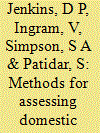|
|
|
Sort Order |
|
|
|
Items / Page
|
|
|
|
|
|
|
| Srl | Item |
| 1 |
ID:
096634


|
|
|
|
|
| Publication |
2010.
|
| Summary/Abstract |
Dynamic simulation is used with defined domestic building variants to investigate internal temperatures of UK dwellings. Factors such as a warming climate and varying internal heat gains are estimated to examine whether UK domestic buildings are likely to be prone to overheating in the future, and therefore require mechanical air conditioning. The study suggests that the ability, or inability, of the occupant to adapt to bedroom temperature is paramount in the understanding of the conditions for overheating. While this is difficult to quantify (and a range of comfort temperatures are proposed), the effect of changing the building construction and geographical location can result in significantly different thermal conditions. As might be expected, the problem appears most noticeable for buildings in the south of the UK and with lightweight constructions. Even with a window-opening schedule applied to such a scenario, the average internal temperature is simulated as being over 28 °C for almost 12% of the year. A different metric, defined as "cooling nights", suggests that there might be a cooling problem in bedroom areas for approximately a third of the year. In the North of the UK, and also for solid wall dwellings, this problem diminishes significantly.
|
|
|
|
|
|
|
|
|
|
|
|
|
|
|
|
| 2 |
ID:
097472


|
|
|
| 3 |
ID:
121326


|
|
|
|
|
| Publication |
2013.
|
| Summary/Abstract |
Due to both changing building design and projected climate change, the conditions within dwellings in the UK are likely to show increased risk to overheating. There is therefore a growing requirement for a suitable industry standard to assess overheating risk in the domestic sector, ensuring that both new dwellings and refurbishments to existing dwellings take future climate into account. This study compares the type of advice gained and the form of calculation used for a series of different summertime overheating analyses. Using simple overheating definitions, a case-study dwelling is simulated for two UK locations across different climate scenarios and the consistency in advice provided by the chosen methods is discussed. The results suggest there are issues around the consistency of such varied models, but also highlight the need to strike a balance between a method that reliably accounts for building thermal performance while also providing a clear and useable approach that can be adopted within industry practice.
|
|
|
|
|
|
|
|
|
|
|
|
|
|
|
|
| 4 |
ID:
094228


|
|
|
|
|
| Publication |
2010.
|
| Summary/Abstract |
With current fuel poverty and carbon-saving policies continuing to miss their targets in the UK, the synergy between the two problems is investigated to highlight an approach that could be mutually beneficial. Focussing on the 550,000 fuel poor socially housed dwellings in the UK, costs of between £3.9 and £17.5 bn are estimated as the required capital investment for achieving deep-cut carbon savings (defined as at least 50%) across this section of the housing stock, with a potential total annual carbon saving of 1.7 MtCO2. It is assumed that such costs would be largely (or totally) state-funded, though additional private investment could clearly increase the possible carbon savings across this section of the stock. The use of these socially housed fuel poor dwellings as low-carbon exemplars is discussed, and benefits for the private housing sector are postulated. The study also focuses on the problem of installing non-cost effective measures, i.e. technologies that would not currently be encouraged by existing subsidy schemes, but which might be necessary for achieving large carbon-saving targets.
|
|
|
|
|
|
|
|
|
|
|
|
|
|
|
|
|
|
|
|
|